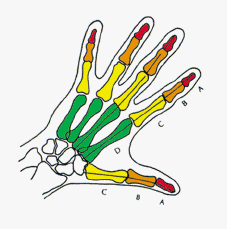In the body as a whole, the Golden Ratio
can be seen to relate the entire height to the distance from head to fingertips,
the head….fingertips distance to the distance from head to navel, the head….navel
distance to the width of the shoulders, the length of the forearm, and the
length of the shin bone. Another easily observed example of the Golden
Ratio’s presence in our physical structure is in the length of the digits
in our hands; as seen in the image, each bone is approximately Phi (1.618)
times longer than the one above it. The Golden Ratio has also been
used to describe the proportions and positions of facial features, and the
greater aesthetic attractiveness of some faces has even been linked to their
close-to-exact correspondence with this model of proportions.
The Golden Ratio can also be applied to the human body, defining the
proportions of human faces and limbs. These rules of proportionality
and the Golden Ratio are often used by artists to create realistic images
of humans, as well as to design architecture and compose artwork that
is pleasing to the eye. Many artists have been inspired by mathematical
patterns, and some have even created art specifically about the Fibonacci
sequence.
|

|

